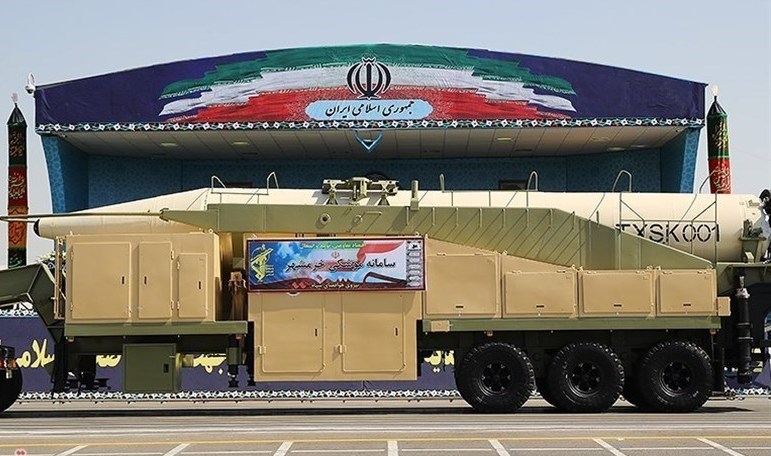 A Khorramshahr Missile. Credit: Tasnim News Agency
A Khorramshahr Missile. Credit: Tasnim News Agency
Iran’s Missile Program: Negotiating a “Non-Negotiable” Issue
Iran has agreed to resume nuclear talks by the end of November, but there are still unaddressed problems concerning the country’s missile program and follow-up talks on this will not be easy.
Many years of attempts by the U.S. and other countries to curtail Iran’s missile program have not stopped Tehran from expanding its missile arsenal. According to the Defense Intelligence Agency, Iran has “the largest and most diverse missile arsenal in the Middle East,” consisting of close-, short-, and medium-range ballistic missiles that can hit targets across the region up to 2,000 kilometers away. The report further indicates that Iran’s development of land-attack cruise missiles also poses a particular threat as “they can fly at low altitude and attack a target from multiple directions.” Iran is estimated to have over 1,000 ballistic missiles that are largely based on North Korean and Russian designs with technical support from China, and is the only country “to develop a 2,000-km missile without first having a nuclear weapons capability.” The country is also further developing its Space-Launch Vehicles (SLVs). In 2020, Tehran successfully launched a military satellite into orbit, and after a failed satellite launch in June this year, the country is preparing for another attempt. Advances in this direction worry Tehran’s critics as an SLV “could potentially be converted into an ICBM” (Intercontinental Ballistic Missile). While dependent on foreign suppliers, the country has the technical and industrial resources, and probably the hardware, to develop an ICBM if it decides to. As such, Iran’s missile program worries some of its neighbors and much of the West. It was also one of the reasons the Trump administration withdrew from the JCPOA.
Yet, imposing limits on the country’s missile program will be a challenge, largely due to its importance for Iran’s conventional capabilities. For instance, Iran lacks a modern air force, and, compared to its rivals Saudi Arabia and the UAE, it has very outdated fighters. Thus, Tehran’s leaders view their missile program as an important part of the country’s defense strategy and as a deterrent against any possible future attacks by its enemies. Iran sees itself as a regional power, and as such it wants to expand its missile program to advance its interests and exert more influence. It has repeatedly declared the missile program as “non-negotiable,” refusing to include it as part of the nuclear deal, both under the Rouhani government and under the current Raisi administration.
For the region and for Western countries, however, Tehran’s missiles pose a major challenge for three reasons. First, they see them as a destabilizing factor in the region, leading to further tensions. Second, they are seen as a threat because some could serve as a potential delivery system for nuclear weapons if Iran makes the choice to attempt a nuclear breakout. Finally, the West fears that Iran could continue to pass them on to non-state actors and other proxy groups such as Hezbollah, Shiite militias in Iraq, Houthi rebels in Yemen, or the Syrian regime. Reportedly, since 2015 the country has provided Houthi rebels with more advanced “ballistic and cruise missiles, as well as long-range unmanned aerial vehicles,” while at the same time equipping Shiite militias in Iraq “with rockets and other small projectiles.” Furthermore, Hezbollah is the largest recipient of Iranian missiles. These are serious challenges, which could complicate the upcoming nuclear talks.
However, despite Tehran’s “non-negotiable” position on its missile program, this might not be the case. Of key importance to the international community is identifying which tools are available to either coerce the Iranian regime to restrict its missile program and identifying effective incentives to encourage Iranian cooperation. That doesn’t mean that it will be easy to meet either side’s demands, but one can’t find out without negotiating the non-negotiable.
In order to reach an agreement, Iran needs to either see the overriding benefits of accepting restrictions, or the overriding consequences of continuing its actions. As the main U.S. strategy is aimed at preventing Iran from acquiring nuclear weapons, subsequent negotiations on Iran’s conventional arsenals will need to consider the Iranian regime’s need for security. Ballistic missiles are an important pillar of the Iranian military, and as such, the focus should be a missile restriction regime rather than an outright ban, which is unrealistic. Further proposals could include payload restrictions, range restrictions, and export bans, while pushing for follow-up talks intended to enhance both Iran’s security and that of its regional neighbors.
In the end while missile negotiations are desirable, a resolution of the issue may not be possible in the foreseeable future. As preventing Iran from acquiring nuclear weapons remains the top priority, lesser issues like its missile arsenal, and the pressure necessary to address them, may have to wait.





